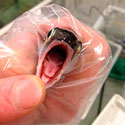3D scans map widespread fish disease

Enteric redmouth disease is a bacterial infection that can kill fish, but is entirely harmless to humans. Symptoms typically take the form of a redness or bleeding in and around the mouth of the fish.
“The new scans show us that the fish are infected through their ultra-thin gills,” explains postdoc Maki Otani, the Department of Veterinary Disease Biology, Faculty of Health and Medical Sciences.
Educated in Japan, Maki Otani has supervised the scanning process, where advanced technology and precision combine to form a higher synthesis. For this reason, the research group can now map with extreme precision the bacterial infection (Yersinia ruckeri) causing enteric redmouth disease in fish.
The disease, which reduces fish well being and increases fish mortality in Danish fish farms, is harmless to humans.
The researchers have scanned the ultra-thin gills of rainbow trout. The gills are a specialised organ whose chief function is to absorb oxygen from the water so the fish can breathe. Only two cell layers separate the outer water from the blood in the fish’s small arteries. The new findings show that the bacterium infects the fish via a specific cell type in the gills.
As little as 60 seconds after the bacterium is introduced into the aquaculture, its presence can be registered in the fish’s bloodstream. The bacterium subsequently infects the fish via its intestine and the lateral line canal– a sensory apparatus running along both sides of the body.
The University of Copenhagen possesses a so-called OPT scanner (Optical Projection Tomography) – a rare piece of equipment enabling researchers to monitor the infection with unparalleled precision.
“The research findings are presumably the first of their kind and the scanning images exceed our wildest dreams,” explains associate professor Martin Raida, the Department of Veterinary Disease Biology, who is heading the project.
Among other things, he is conducting research in developing vaccines. The Danish fish production industry currently vaccinates its fish, also against enteric redmouth disease, but to date this has not solved the problem. Martin Raida hopes that the new knowledge can contribute to the development of a more effective vaccine against enteric redmouth disease. This will contribute to bring down the amount of antibiotics used and thus reduce the burden on the environment.
Maki Otani, mobile: + 45 42 46 88 82
Martin Raida, mobile: + 45 60 66 67 01
Media Contact
All latest news from the category: Agricultural and Forestry Science
Newest articles

New model of neuronal circuit provides insight on eye movement
Working with week-old zebrafish larva, researchers at Weill Cornell Medicine and colleagues decoded how the connections formed by a network of neurons in the brainstem guide the fishes’ gaze. The…

Innovative protocol maps NMDA receptors in Alzheimer’s-Affected brains
Researchers from the Institute for Neurosciences (IN), a joint center of the Miguel Hernández University of Elche (UMH) and the Spanish National Research Council (CSIC), who are also part of…

New insights into sleep
…uncover key mechanisms related to cognitive function. Discovery suggests broad implications for giving brain a boost. While it’s well known that sleep enhances cognitive performance, the underlying neural mechanisms, particularly…



